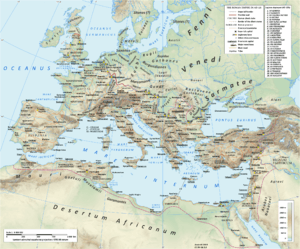Tauri

Tauri (Antik Yunanca: Ταῦροι), ya da Scythotauri, Tauri Scythae, Tauroscythae (Yaşlı Plinius, Doğanın Tarihi 4.85) Kırım Yarımadası'nın güney kıyısına yerleşmiş olan halktır. Kırım Dağları'nda ve bu dağlar ile Karadeniz arasında kalan şeritte yaşamaktaydılar. Kendi zamanlarında bu bölgeye Taurica, Taurida ve Tauris şeklinde isimler vermişlerdir.
Heredot Tarihi'nde savaş ve yağmacılık ile geçinen insanlar olarak tarif edilmişlerdir. Tauriler "Bakire tanrıça"ya tapınmaları, yolunu şaşıran Yunanları ve gemisi karaya oturmuş, kaza geçirmiş gezginleri tanrıçaya kurban etmeleri ile ünlenmişlerdir [1]
Heredot Taurilerin coğrafi olarak İskitler'in yaşadığı bölgede yaşadıklarını ama İskit olmadıklarını belirtir.[2] Pritsak ve Golb'a (1982) göre ise Tauriler Türk kökenli bir halktı.[3]
Yunanlar Taurilerin tanrıçasını Agamemnon'un Artemis'ten veya Iphigeneia'dan olan kızı olarak tanımlamışlardır. Tauriler'in insan kurban etme geleneği, oyun yazarı Euripides'in Iphigeneia Taurus'ta adlı eserinde anlattığı, Helenler'in Iphigenia ve Orestes efsanelerine ilham vermiştir.
Herodot'un aktardığına göre Tauriler tanrıçalarına sunacakları kurbanların kafalarını kesiyorlardı. Vücütlarını ise gömüyor veya uçurumdan atıyor, ardından kurbanın kesik kafasını çivileyip asıyorlardı. Savaş esirlerinin de aynı şekilde kafalarını keserlerdi ve evlerinin yüksek bir bölümüne "evi koruyacağı inancına dayanarak" asarlardı.
Buna rağmen sonunda Kırım sahilleri, özellikle Chersonesos bölgesi Yunan (ve ardından Romalı) kolonilerin egemenliği altına girdi. Yine de Tauriler bu bölgede Yunan güçlerine karşı büyük tehdit oluşturmayı sürdürdüler. Ana merkezleri olan Symbolon'dan (Günümüzde Balaklava) Karadeniz'deki gemilere karşı baskın, yağma ve korsanlık faaliyetleri yürüttüler. MÖ 2. yüzyıla gelindiğinde İskit kralı Scilurus'un müttefiki oldular.
Adlandırma
Tauri büyük olasılıkla "dağ insanları" anlamına gelmektedir.[4][5] Bu sözcüğün ise eski bir kökeni olan ve "dağ" anlamına gelen Tau sözcüğünden geldiği/türediği düşünülmektedir.[6][7] Bununla birlikte Tau'nun birden fazla dilde "dağ" sözcüğünü karşıladığı görülmektedir.[8] Toira Asurca dağ ya da dağ sırası anlamındadır. Türk dilleri'nde Tau; "dağ", "büyük, yuvarlak yapı", "yığıntı" anlamlarına gelir. Keltler de "kule" sözcüğü için tor, tour sözcüklerini kullanmaktadırlar.[9][10]
Ayrıca Bakınız
Kaynakça
- ↑ Hdt. 4.103 "the Tauri have the following customs: all ship-wrecked men, and any Greeks whom they capture in their sea-raids, they sacrifice to the Virgin goddess1 as I will describe: after the first rites of sacrifice, they strike the victim on the head with a club; according to some, they then place the head on a pole and throw the body off the cliff on which their temple stands; others agree as to the head, but say that the body is buried, not thrown off the cliff. The Tauri themselves say that this deity to whom they sacrifice is Agamemnon's daughter Iphigenia. As for enemies whom they defeat, each cuts his enemy's head off and carries it away to his house, where he places it on a tall pole and stands it high above the dwelling, above the smoke-vent for the most part. These heads, they say, are set up to guard the whole house. The Tauri live by plundering and war. " (trans. Godley)
- ↑ 4.99 "Beyond this place [Carcinitis on the Ister], the country fronting the same sea is hilly and projects into the Pontus; it is inhabited by the Tauric nation as far as what is called the Rough Peninsula; and this ends in the eastern sea. For the sea to the south and the sea to the east are two of the four boundary lines of Scythia, just as seas are boundaries of Attica; and the Tauri inhabit a part of Scythia like Attica, as though some other people, not Attic, were to inhabit the heights of Sunium from Thoricus to the town of Anaphlystus, if Sunium jutted farther out into the sea. I mean, so to speak, to compare small things with great. Such a land is the Tauric country. But those who have not sailed along that part of Attica may understand from this other analogy: it is as though in Calabria some other people, not Calabrian, were to live on the promontory within a line drawn from the harbor of Brundisium to Tarentum. I am speaking of these two countries, but there are many others of a similar kind that Tauris resembles." (trans. A. D. Godley)
- ↑ Pritsak O. & Golb. N: Khazarian Hebrew Documents of the Tenth Century, Ithaca: Cornell Univ. Press, 1982.
- ↑ The Edinburgh encyclopaedia, 1830, p. 339.
- ↑ The Juvenile, 1853, p. 217
- ↑ Charles Knight, The English Cyclopedia: Geography, Bradbury et Evans, 1855, p. 803.
- ↑ Charles Anthon, A System of Ancient and Mediæval Geography, Harper & brothers, 1855, p. 238.
- ↑ Charles ANTHON (LL.D.), A Classical Dictionary: containing an account of the principal proper names mentioned in ancient authors, p. 1294.
- ↑ John Buchan Telfer, The Crimea and Transcaucasia, H.S. King & Company, 1876, p. 92.
- ↑ Henry Dauby Seymour, Russia on the Black Sea and Sea of Azof, Murray, 1855, p. 171.